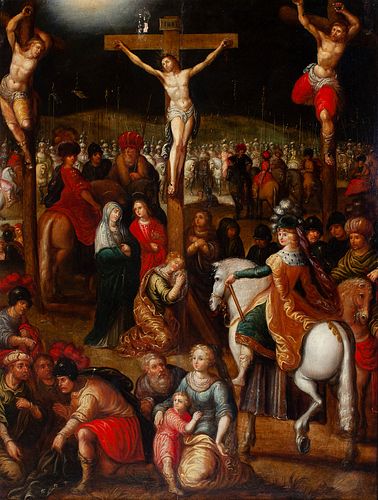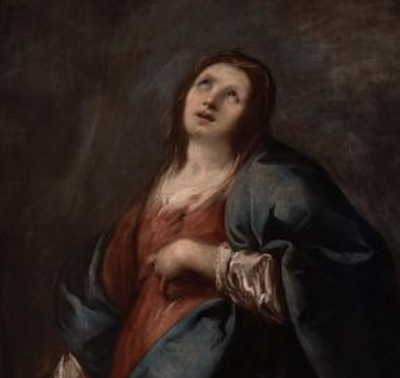Antwerp School of the 17th century. Following models of LOUIS DE CAULLERY (Caullery, circa 1580- Antwerp, 1621). "The Crucifixion". Oil on panel. Crad
Lot 32
About Seller
Setdart Auction House
Carrer Aragó 346
Barcelona
Spain
Setdart Subastas was born in 2004 and is currently the first online art auction in Spain with solidity, prestige and reliability guaranteed by our more than 60,000 users. Setdart has a young, dynamic and enterprising team ready to successfully manage the purchase and sale of art works through custom...Read more
Estimate:
EUR€3,000 - EUR€3,500
$3,260.87 - $3,804.35
Absentee vs Live bid
Two ways to bid:
- Leave a max absentee bid and the platform will bid on your behalf up to your maximum bid during the live auction.
- Bid live during the auction and your bids will be submitted real-time to the auctioneer.
Bid Increments
| Price | Bid Increment |
|---|---|
| EUR€0 | EUR€10 |
| EUR€200 | EUR€25 |
| EUR€500 | EUR€50 |
| EUR€1,000 | EUR€100 |
| EUR€3,000 | EUR€200 |
| EUR€5,000 | EUR€500 |
| EUR€10,000 | EUR€1,000 |
| EUR€20,000 | EUR€2,000 |
| EUR€50,000 | EUR€5,000 |
About Auction
By Setdart Auction House
May 31, 2021
Set Reminder
2021-05-31 08:30:00
2021-05-31 08:30:00
America/New_York
Bidsquare
Bidsquare : OLD MASTERS - Day 1
https://www.bidsquare.com/auctions/setdart-auction-house/old-masters---day-1-6998
Setdart Auction House sofia@setdart.com
Setdart Auction House sofia@setdart.com
- Lot Description
Antwerp School of the 17th century. Following models of LOUIS DE CAULLERY (Caullery, circa 1580- Antwerp, 1621). "The Crucifixion". Oil on panel. Cradled. With chips. Measurements: 70 x 54 cm; 101 x 81 cm (frame). The present work closely follows the models established by the Flemish painter Louis de Caullery. His most significant productions are elegant courtly representations, both in interiors and gardens, although he also made some paintings of religious themes, such as "The Crucifixion" preserved in the Museo del Prado, and that we can put in parallel with the work presented here. The Crucifixion is probably the most characteristic Christian image, and was undoubtedly one of the most represented and collected in Habsburg Spain. Sculptures or paintings of Christ on the cross, in their various forms, were found in almost every church and chapel, and in private homes they served as devotional objects. The themes related to the Passion, which emphasize the human character of Jesus and his suffering, were central to the spiritual life of Golden Age Spain. In depicting these scenes, painters and sculptors aimed to move the viewer just as poets and preachers did with their respective means of expression. Given the public nature of devotion at the time and the familiarity of seventeenth-century Spaniards with sacred art, images such as these were for most of them inseparable from the pious experience. Louis de Caullery was a French painter who in 1594 began his artistic training in Caullery as an apprentice to Joos de Momper in the guild of St. Luke, where he enrolled as a master in the 1602/1603 course. Despite his training at Momper's side, Caulery's work is closer to Mannerist sophistication than to Baroque naturalism. He was clearly influenced by some of the engravings of Hans Vredeman de Vries, mainly, from whom he took the whimsical architectural backgrounds. His work also shows similar characteristics to the painting of the artist Frans Francken II, which can be seen especially in the anatomical treatment of the figures, although in Caulery etas, they are always represented as a volumetric and massive aesthetic, both in the courtly scenes, as in the allegorical ones, which form the most interesting part of his production. Regarding the religious scenes, he made a large production, headed by the Calvary motif, which he repeated on numerous occasions.
- Shipping Info
-
In-house shipping available. Please inquire at admin@setdart.com.
-
- Buyer's Premium



 EUR
EUR CAD
CAD AUD
AUD GBP
GBP MXN
MXN HKD
HKD CNY
CNY MYR
MYR SEK
SEK SGD
SGD CHF
CHF THB
THB
















